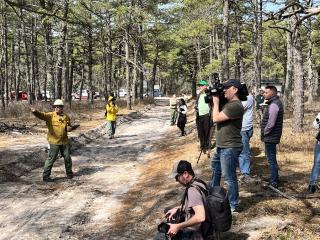Forest Service partners in New Jersey wildfire fuel break projects
NEW JERSEY—The USDA Forest Service recently contributed to two forest fuel break projects to reduce the growing threat of wildfire in New Jersey.
“They had a major fire in the state last July and the prior June,” said Tim Regan, currently detailed as an Eastern Region cooperative fire specialist. “New Jersey is at an elevated risk for wildfires in the East due to their extensive pitch pine, Virginia pine and cedar forests.”
Forests with dense vegetation in the understory can be at high risk for wildfires, particularly when drought, high temperatures and low humidity exist. Fuel breaks serve to lower the risk of a wildfire moving from one part of the forest to the next by reducing vegetation which could serve as fuel.
Regan participated in the Forest Service and State of New Jersey collaboration which created a fuel break in Roosevelt City, a development in the Pinelands of New Jersey. This project tied into another project known as the Warren Grove fuel break on the border of Ocean and Burlington Counties.
“Both projects are important to reduce wildfire risk because New Jersey has been impacted greatly by wildland fire in its history especially with wildland urban interface that exists today,” Regan added.
The Roosevelt City fuel break was completed by a combination of mechanical means and prescribed burns. It ties into other fuel breaks and is very large, about 34 miles in total.
Regan said the burning for fuel reduction doesn’t eliminate the fire risk, but it helps to control fire intensity. “If you had two sides of a road and one side is treated with a prescribed burn, that side will be less likely to experience extreme fire activity.”
The partnership also served to protect properties next to military installations in the Pinelands from the increased risk of wildfire due to a changing local climate, noted a Department of Defense press release.
A combination of Department of Defense, direct funding, and Infrastructure Investment and Jobs Act funding was provided for the multi-year project that started about 16 months ago and was completed in February, before the start of fire season.
The DoD provided $1.7 million in Readiness and Environmental Protection Integration funding for the project. Additional funding sources included $364,000 from the New Jersey Department of Environmental Protection, $127,000 from the USDA Forest Service in State Fire Assistance, $64,000 through the Infrastructure Investment and Jobs Act, and $107,000 from Ocean County.
Regan said it was the first time he was aware of that the DoD provided the majority of funding for a wildland fire prevention project of this complexity.


